I leave behind Peñafiel, its castle and famous wineries; ahead, the plain is losing its harshness as it slowly gets higher, towards more beautiful and faraway regions. The blue sky is partly cloudy with cumulus humilis, the wind caresses the wheat fields, putting a dozen shades on the green and gold; the sun shines behind the clouds every now and then with sweet tenderness and gets the best colours from the flowers, the trees, the stones, the fields, the whole countryside. It’s a superb afternoon, full of glory, able to bestow onto the most wretched one some joy of life.
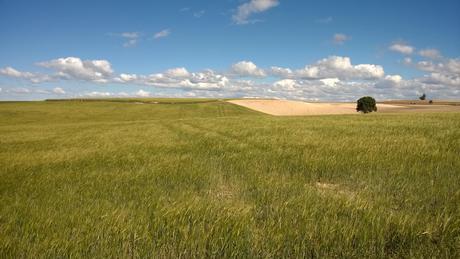
Beatifying moment between La Horra and Cabañes.
I guess that, by now, every reader has been acquainted with my preference for natural and off route places; so, noone will be surprised to learn that, once I left the “busy” Peñafiel, I moved away from the highway N-122 and, pulling to the left, I took a secondary road going Northeast, towards Roa, which is also a wine-centered town. I didn’t stop here, though: for the moment, I had enough of wine making and vineyard cultives. So, I headed where my instinct took me, on the way to La Horra, Sotillo de la Ribera, Cabañes de Esgueva… Landscape-wise, the best of this day’s journey had but started, and along these stretches in the flat highlands, sown with wheat, oats and barley, I was lucky enough to take some splendid shots; I only regret not being a better photographer.

Wheat fields between Sotillo de la Ribera and Cabañes de Esgueva.
Along these villages the landscape starts changing little by little, leaving behind and below the arid plains, the road climbs slowly among valleys and ridges towards higher lands. As I approach the first foothills of the Sierra de la Demanda, I start coming across some forest patches. The road, almost empty, allows for a sudden stop anywhere, and I can try some selfies like this (which you’ve already seen):
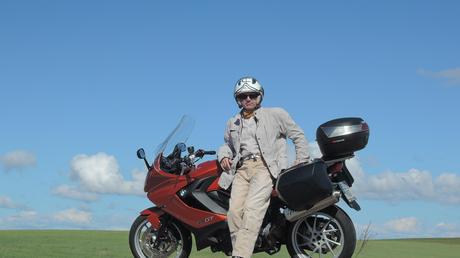
Selfie, somewhere between La Horra and Bahabón.
I’m enjoying so much that, before I realize, I’ve already crossed eastwards the route A(septic)-1, and I need to check the map to know where I want to go. As I’m standing by Rosaura on the road shoulder, a local stops by and asks me: everything ok, do you need some help? I thank him, he smiles back and leaves. “I’m on the right way”, I say to myself.
Many years ago, when I was so young that the world had no limits, spatial nor temporal, I had a girlfriend with whom I took some of my first trips; during one of these, we passed a village called Santo Domingo de Silos; from that visit, besides a good imprint, I keep only an image in my memory: a monastery with a huge fir tree in its entrance’s courtyard. I wanted now to make a destination out of that monastery and that fir tree, that place in my past.
And I hit it. But, before that, I’ve ridden through lovely villages, and I’ve been gifted with gorgeous landscapes. Along this minor route, gently riding my bike, wrapped in my white armour, I calmly contemplate the landscape around me and I think, thirty years of coming and going have been needed for me to learn now that the best way of traveling is… just slowly.
I halt at a village called Pinilla Trasmonte and park by the church. I’ve already said in this blog that I never stop being amazed by the Catholic Church constructing zeal along one thousand years. Even if only for this, it deserves my respect. There is no hamlet nor small village, district nor county, quarter nor town in any Spanish region where the Church has not erected a church, a parish, a sanctuary, a chapel, a cathedral, a monastery or a shrine. I can’t conceal my admiration nor -I admit- my envy: what kind of faith is needed for such energy, for such momentum? And I don’t care if it’s an absurd and baseless faith! All fait is, so what? The main thing is: whomever has such faith, has never felt empty as I often feel. The local priest, the bishop, the prior, the abbot, the monk… probably none of them ever felt this fool urge, this yearning to journeying to nowhere: all of them knew who they were, all believed -mistaken or not, who cares?- in what they were doing; they lived and died where they thought God had placed them, and their lives meant something for themselves. Mine, however…
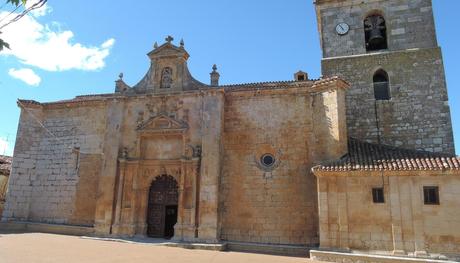
Church at Pinilla Trasmonte, under the early evening sun.
Most cozy corners in the villages attract me as a magnet, sometimes irresistibly: wherever I glimpse an old house, a tiled roof, an adobe wall, a wooden old door, I walk there like mesmerized. Right behind the church of Pinilla there is one of those romantic corners: two or three empty houses in a row that probably no more than three dacades ago were inhabited by old couples who also knew who they were, and whose remains rest now -no doubt- in some neglected local graveyard invaded by nettles.
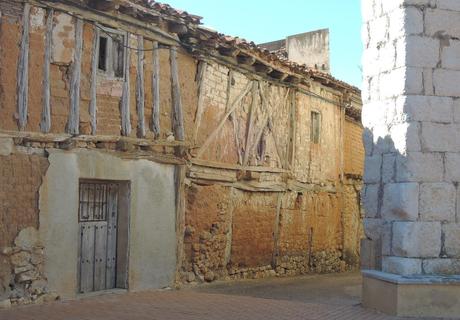
Cozy corner behind the church of Pinilla Trasmonte.
And there she is, my “faithful” Rosaura, as a bridled mount waiting for the rider to finish visiting the village.
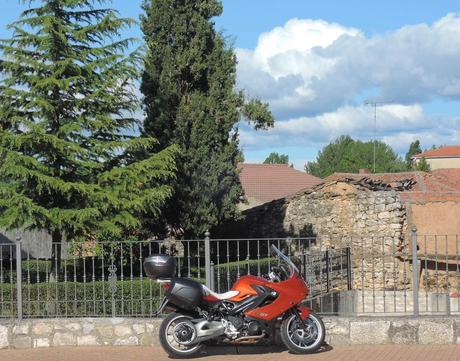
But Pinilla is just one among the many small villages along my way to Silos. One league eastwards I arrive to Santa María del Mercadillo, where I’m quite welcome: the locals are kind, serviceable, and they feel honoured by my visit; they talk to me, they ask me, they direct me, they suggest me. On top of a ridge behind the village there is an old graveyard, very old and very small, surrounded by a sturdy stone wall; inside, the grass is so overgrown that it almost hides the only cross, a rusty old one, enduring the pass of centuries. I climb the ridge and stop there for a moment. It’s a melancholy view: the forgotten cross, lonely inside its sacred enclosure, leaning on the grass whirled by the wind, still waiting for the Judgement day.
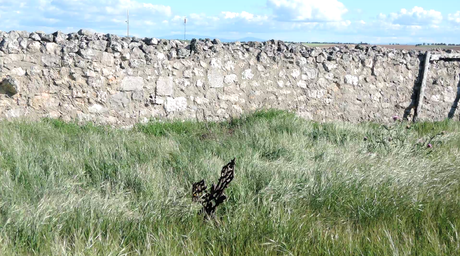
Click on this short video for understanding this moment.
Besides, I find some other little gifts in this village that move me, bringing me back to the days of my childhood, in a part of Spain that was as deeply -almost primitively- rural as it was deprived of any complexes, in those times when schools didn’t need special facilities, when teachers were called maestros (an old fashion way of saying teacher in Spanish) and, for teaching, they only needed a blackboard, a piece of chalk and a stout wooden ruler; and those times when streets could be called after José Antonio (a Spanish politician prior to Franco seized the power).
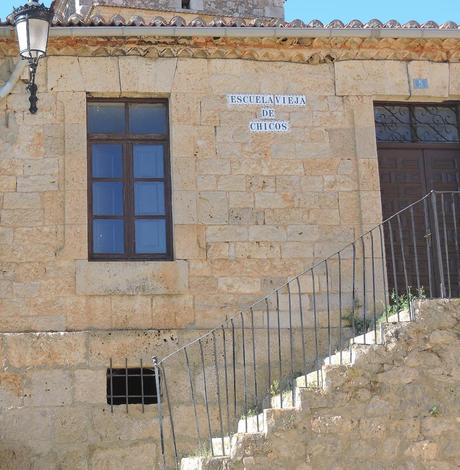
Old boys’ school, in Sta María del Mercadillo.
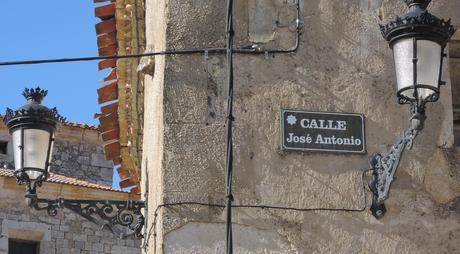
José Antonio street, in Sta. María del Mercadillo.
Once I finish my visit to this hamlet (I’d have stayed overnight had there been a hostage) I say farewell to the old men -may God be with you, I say, old style, and they stare at me in an odd way-and, getting on the bike, I start and keep going.
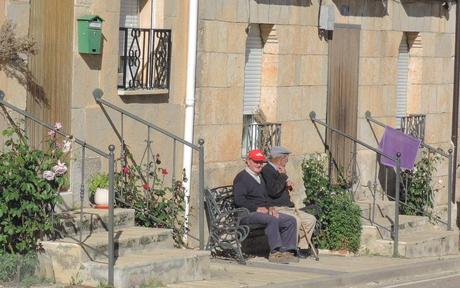
These ones, they’re certainly not in a hurry at all.
Rosaura’s tyres shall yet roll over the short streets of Cieruelos and Brihongos (de Cervera); the air is getting cooler, the forest patches happen more frequently, the landscape becomes magnificent, and superb when I join the panoramic route from Aranda to Silos: wherever you look at, it’s a gift for the senses. Finally, shortly before arriving to my destination, there opens the giant and gorgeous Yecla, the defile that makes for the southern gate to the Mataviejas’ valley; Yecla is like a herald to the region whereof it is the natural entrance.

The two rocky crests forming La Yecla, the defile gate to the valley where Silos sits.
The defile is so narrow that there was no room for the road, and a tunnel had to be carved in the rock.
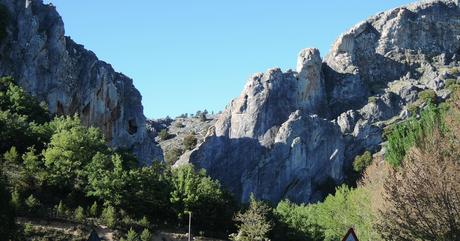
When you get closer to La Yecla, you can guess how narrow.
As a matter of fact, the natural pass is so narrow in some spots that you can touch both sides with each hand without stretching your arms. Only the water, with its erosive force, has been able to make its way through this crack in the rock wall, along millions of years; but a narrow way, where only the water can go.
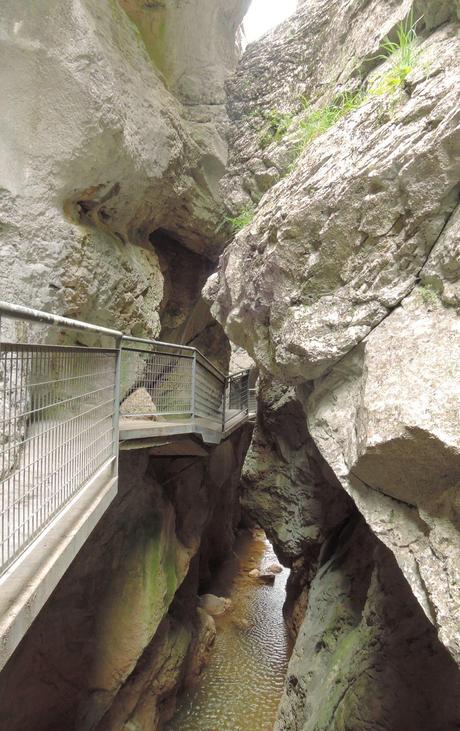
Here you can perceive the narrowness; underneath goes the stream quite originally called Cauce (means “Riverbed”).
After beholding this wonder of Nature and walking the short sightseeing route, it’s only one league left to finally get to Santo Domingo de Silos.
Silos is famous for its monastery, Santo Domingo, and there’s actually not much more to it. Everything here spins around the church, the cloister, the monks. But for a few old neighbours, all the rest is hotels, gift shops, restaurants, bars. But, at this time of the year, it’s not yet too busy. Not at all, I’d say.
Right upon arriving, to my right, I find the monastery’s wall, then the gate, and right in the middle of the courtyard across this gate… there it is, the giant centennial fir tree I recalled from my youth, only thirty years older, both the tree and me.
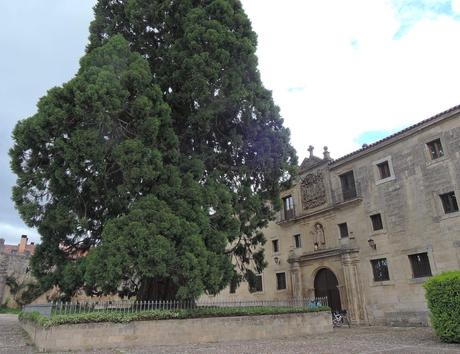
Centennial fir by the monastery’s entrance.
My intuition, hand in hand with my traveler’s instinct, advise me to disregard the first three suggestive hotels offering accomodation to the tourists, right alongside the road. I keep riding barely one hundred metres further and, around the monastery’s church corner, a cobbled street to my right goes down to the riverside and underneath a stone archway, at the other side of which there’s another, more hidden hotel, at the very foot of a green hill onto where the reddish sun is shining beautifully, getting from the land and vegetation the most beautiful colours you can imagine. I instantly fall in love with the whole, a true love at first sight: the cobblestones, the small hotel, the arch, a dyke along the street, pouring its water to the Mataviejas river, the bright green hillside with a stone hermitage in the middle… everything, every one of these elements seems to have been placed there for suiting my tastes…
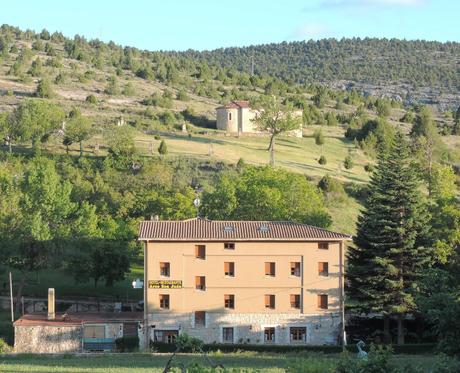
Mi hotel, at the foot of the hill.
The owner is a simple man, as non-pretentious as the hotel he manages. The room price suits well my budget. I ask him to show me around and, when checking the room, this is what I see:
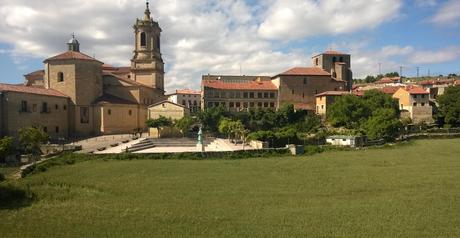
Church of the monastery of Santo Domingo, from my hotel’s window.
Asking for more would be a sin. I’m staying here. I feel happy: my instinct and my intuition have served me quite well all along this day. I park Rosaura by the hotel, take the suitcases, change shoes and the first thing I do is to climb the slope to the hermitage, which is shouting at me since I set my eyes on it. What a pleasant feeling! What a lovely weather!, what a silence! You can only hear the cowbells in the distance, some infants’ voices far away, and, every now and then, a bell telling the quarters.
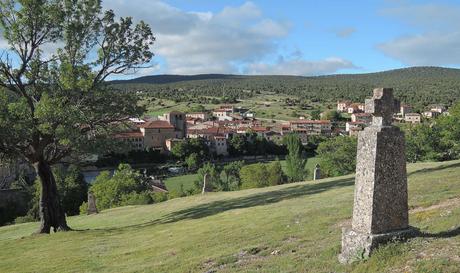
View from the hermitage of Silos.
On the slope, below the hermitage, there is a Way of the Cross, built on stone, and I feel as if it wanted to tell me something. When I turn my eyes back, the monastery, the village, the whole valley are smiling to me with the sun shining on the roofs, on the stone, on the trees and the fields.

Santo Domingo de Silos and the valley of Mataviejas river.
I get to the hermitage, called Virgen del Camino; a very suitable name, because (coincidence or not) here goes the way (camino) that Rodrigo Díaz de Vivar (the moor-killer medieval hero), nicknamed Cid Campeador, took when he was banished from Castile. And it’s a sight that lightens my heart, this hermitage which looks to the setting sun with the eyes of its windows, surrounded by greeen there on the hill slope.
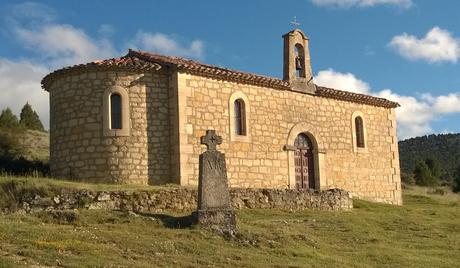
Hermitage Virgen del Camino.
On its southern side, shielded from the cool breeze, sunbathed, there is a stone whose surface is polished and worn by the thousands of people that have been sitting on it. And there I sit myself, closing my eyes, letting the slumber get hold of me, resting from this long and eventful day…
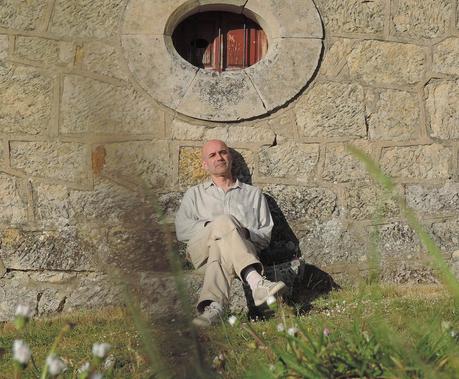
As the sun sets and dusk comes, the evening gets a bit cooler and, though I’m sheltered from the breeze and sunbathing, I start feeling cold. It’s about time for going down to the village and looking for somewhere to have dinner. As I pass by the basilica’s side, I notice a huge mural that I passed unnoticed when arriving. A pious mural that, considering my last days’ thoughts, among all the village’s visitors seems to be addressed only to me:
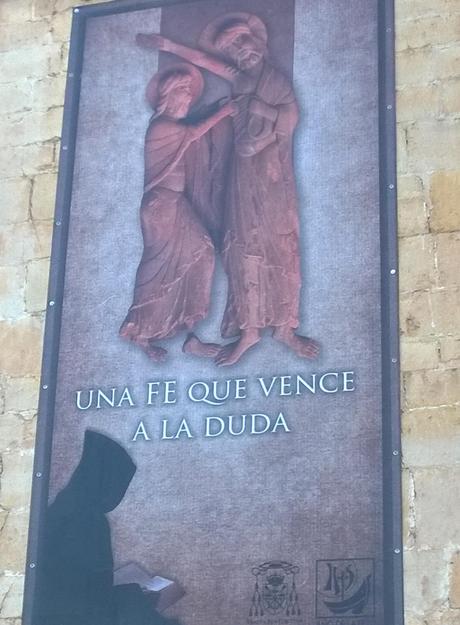
“A faith that defeats doubt”. Oh, yes, that faith..! If only I could feel it!

